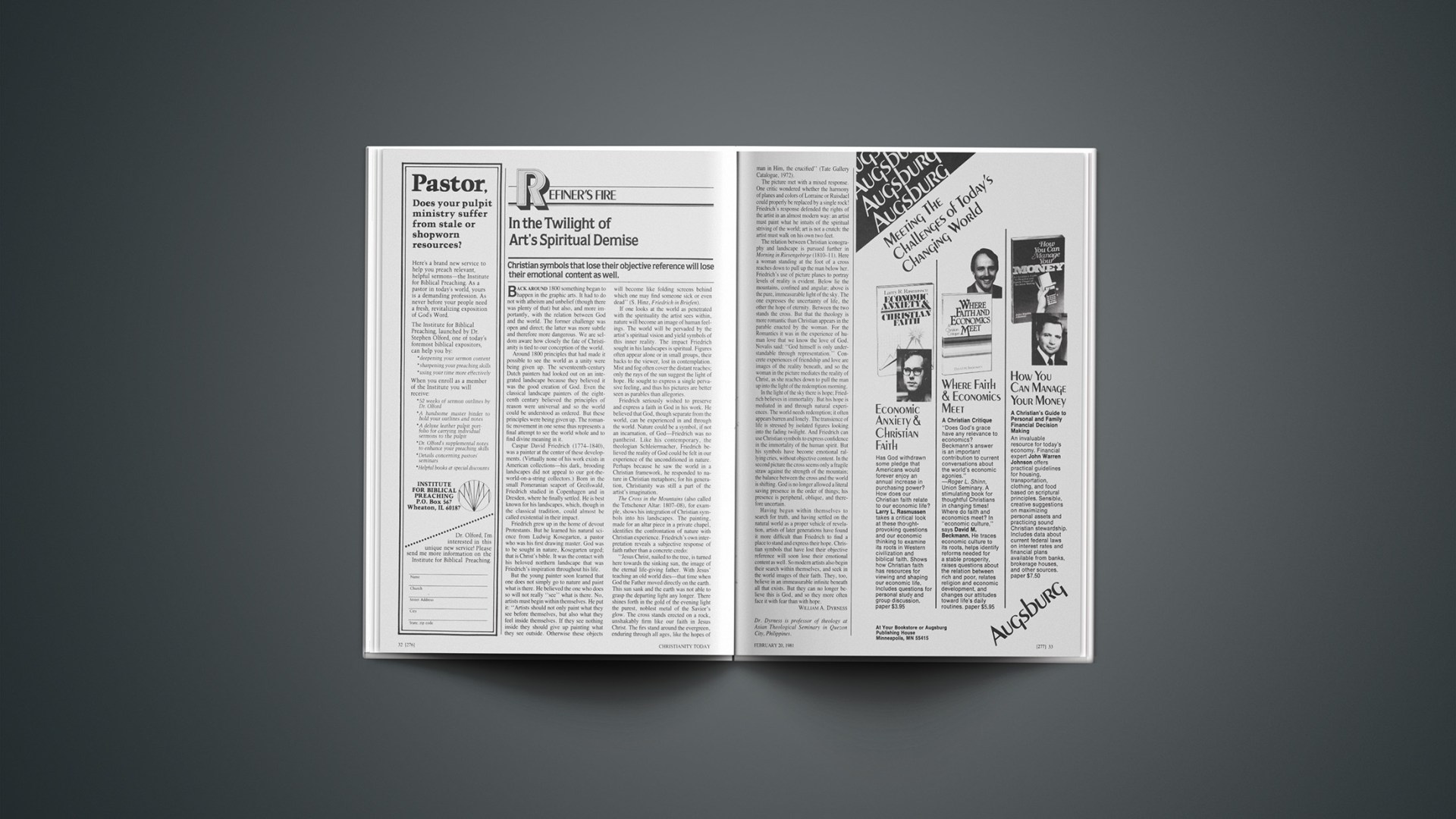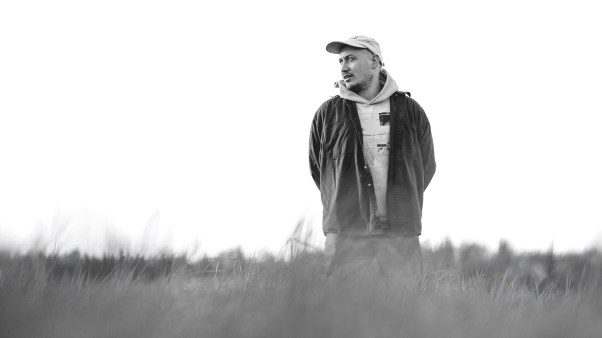Christian symbols that lose their objective reference will lose their emotional content as well.
Back around 1800 something began to happen in the graphic arts. It had to do not with atheism and unbelief (though there was plenty of that) but also, and more importantly, with the relation between God and the world. The former challenge was open and direct; the latter was more subtle and therefore more dangerous. We are seldom aware how closely the fate of Christianity is tied to our conception of the world.
Around 1800 principles that had made it possible to see the world as a unity were being given up. The seventeenth-century Dutch painters had looked out on an integrated landscape because they believed it was the good creation of God. Even the classical landscape painters of the eighteenth century believed the principles of reason were universal and so the world could be understood as ordered. But these principles were being given up. The romantic movement in one sense thus represents a final attempt to see the world whole and to find divine meaning in it.
Caspar David Friedrich (1774–1840), was a painter at the center of these developments. (Virtually none of his work exists in American collections—his dark, brooding landscapes did not appeal to our got-the-world-on-a-string collectors.) Born in the small Pomeranian seaport of Greifswald, Friedrich studied in Copenhagen and in Dresden, where he finally settled. He is best known for his landscapes, which, though in the classical tradition, could almost be called existential in their impact.
Friedrich grew up in the home of devout Protestants. But he learned his natural science from Ludwig Kosegarten, a pastor who was his first drawing master. God was to be sought in nature, Kosegarten urged; that is Christ’s bible. It was the contact with his beloved northern landscape that was Friedrich’s inspiration throughout his life.
But the young painter soon learned that one does not simply go to nature and paint what is there. He believed the one who does so will not really “see” what is there. No, artists must begin within themselves. He put it: “Artists should not only paint what they see before themselves, but also what they feel inside themselves. If they see nothing inside they should give up painting what they see outside. Otherwise these objects will become like folding screens behind which one may find someone sick or even dead” (S. Hinz, Friedrich in Briefen).
If one looks at the world as penetrated with the spirituality the artist sees within, nature will become an image of human feelings. The world will be pervaded by the artist’s spiritual vision and yield symbols of this inner reality. The impact Friedrich sought in his landscapes is spiritual. Figures often appear alone or in small groups, their backs to the viewer, lost in contemplation. Mist and fog often cover the distant reaches; only the rays of the sun suggest the light of hope. He sought to express a single pervasive feeling, and thus his pictures are better seen as parables than allegories.
Friedrich seriously wished to preserve and express a faith in God in his work. He believed that God, though separate from the world, can be experienced in and through the world. Nature could be a symbol, if not an incarnation, of God—Friedrich was no pantheist. Like his contemporary, the theologian Schleiermacher, Friedrich believed the reality of God could be felt in our experience of the unconditioned in nature. Perhaps because he saw the world in a Christian framework, he responded to nature in Christian metaphors; for his generation, Christianity was still a part of the artist’s imagination.
The Cross in the Mountains (also called the Tetschener Altar: 1807–08), for example, shows his integration of Christian symbols into his landscapes. The painting, made for an altar piece in a private chapel, identifies the confrontation of nature with Christian experience. Friedrich’s own interpretation reveals a subjective response of faith rather than a concrete credo:
“Jesus Christ, nailed to the tree, is turned here towards the sinking sun, the image of the eternal life-giving father. With Jesus’ teaching an old world dies—that time when God the Father moved directly on the earth. This sun sank and the earth was not able to grasp the departing light any longer. There shines forth in the gold of the evening light the purest, noblest metal of the Savior’s glow. The cross stands erected on a rock, unshakably firm like our faith in Jesus Christ. The firs stand around the evergreen, enduring through all ages, like the hopes of man in Him, the crucified” (Tate Gallery Catalogue, 1972).
The picture met with a mixed response. One critic wondered whether the harmony of planes and colors of Lorraine or Ruisdael could properly be replaced by a single rock! Friedrich’s response defended the rights of the artist in an almost modern way: an artist must paint what he intuits of the spiritual striving of the world; art is not a crutch: the artist must walk on his own two feet.
The relation between Christian iconography and landscape is pursued further in Morning in Riesengebirge (1810–11). Here a woman standing at the foot of a cross reaches down to pull up the man below her. Friedrich’s use of picture planes to portray levels of reality is evident. Below lie the mountains, confined and angular; above is the pure, immeasurable light of the sky. The one expresses the uncertainty of life, the other the hope of eternity. Between the two stands the cross. But that the theology is more romantic than Christian appears in the parable enacted by the woman. For the Romantics it was in the experience of human love that we know the love of God. Novalis said: “God himself is only understandable through representation.” Concrete experiences of friendship and love are images of the reality beneath, and so the woman in the picture mediates the reality of Christ, as she reaches down to pull the man up into the light of the redemption morning.
In the light of the sky there is hope; Friedrich believes in immortality. But his hope is mediated in and through natural experiences. The world needs redemption; it often appears barren and lonely. The transience of life is stressed by isolated figures looking into the fading twilight. And Friedrich can use Christian symbols to express confidence in the immortality of the human spirit. But his symbols have become emotional rallying cries, without objective content. In the second picture the cross seems only a fragile straw against the strength of the mountain; the balance between the cross and the world is shifting. God is no longer allowed a literal saving presence in the order of things; his presence is peripheral, oblique, and therefore uncertain.
Having begun within themselves to search for truth, and having settled on the natural world as a proper vehicle of revelation, artists of later generations have found it more difficult than Friedrich to find a place to stand and express their hope. Christian symbols that have lost their objective reference will soon lose their emotional content as well. So modern artists also begin their search within themselves, and seek in the world images of their faith. They, too, believe in an immeasurable infinite beneath all that exists. But they can no longer believe this is God, and so they more often face it with fear than with hope.
WILLIAM A. DYRNESS1Dr. Dyrness is professor of theology at Asian Theological Seminary in Quezon City, Philippines.










